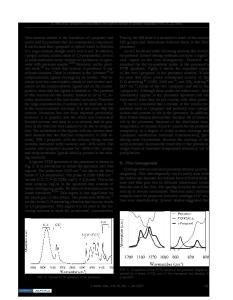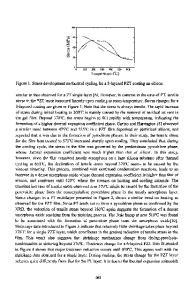Self-poling Effects in Sol-gel Derived Pb(Zr 1-x Ti x )O 3 Thin Films
- PDF / 111,528 Bytes
- 6 Pages / 612 x 792 pts (letter) Page_size
- 57 Downloads / 296 Views
U12.24.1
Self-poling Effects in Sol-gel Derived Pb(Zr1-xTix)O3 Thin Films Jinrong Cheng, Nan Li and L.Eric Cross Material Research Laboratory, The Pennsylvania State University University Park, PA 16802 Zhongyan Meng School of Mater. Sci. and Eng., Shanghai University, Shanghai 201800, P.R.China ABSTRACT Based on the direct piezoelectric effect, the measurement of piezoelectric module d33 was conducted to examine the self-poling effect in sol-gel derived Pb(Zr1-xTix)O3 (PZT) thin films. It is observed that as-prepared PZT thin films have piezoelectric responses being dependent upon the film thickness and composition. The higher d33 of 26 pC/N is achieved for ~0.4 µm thick PZT thin films with Zr/Ti ratio of 53/47. The d33 value decreases with increasing the film thickness for as-prepared PZT thin films, however, increases for the same film after external poling. The origin of the self-poling effect was briefly discussed based on the formation of an internal bias field in PZT thin films.
INTRODUCTION In general, an electric poling process is required for bulk ferroelectric materials to be used as piezoelectric sensors and actuators. However, a self-poling effect as one of unique properties is observed for ferroelectric thin films [1,2]. Polarized ferroelectric thin films, such as PZT, can be obtained directly after their preparation without applying an external poling field. This property is extremely important for integrated pyroelectric sensor array applications of ferroelectric thin films since a large number of small elements can be poled uniformly in an easy way avoiding the damage to integrated circuits and elements caused by the additional high field poling. The internal bias field in ferroelectric thin films, which can be described as an imprint phenomenon, is considered a limitation for ferroelectric random access memory (FRAM) applications [3], however, is assumed the major contribution to the observed self-poling effect. Nevertheless, the origin of the internal bias field capable of poling the ferroelectric thin films is still far from being clear and requires further studies. The internal bias field can be formed by dipolar-defect complexes, which are produced by abnormal distribution of defects, acceptors, oxygen vacancies or other defects during the fabrication [4,5]. Self-polarizations are kinds of non-switching polarizations, which are hard to be characterized by the measurement of ferroelectric hysteresis loops. Usually, the self-polarization can be checked by the measurement of the pyroelectric coefficient of the as-prepared film sample [6]. A more simple method is to measure the piezoelectric constant d33 for an as-prepared film [7]. According to the relationships of d33 =2Qeffε0εP, where Qeff is the effective electrostrictive coefficient (for the PZT thin films, Qeff is little change with the external electric field and temperature), ε0 (8.85×10-12 F/m) is the absolute permittivity, ε is the relative permittivity and P is the polarization, the d33 value may indirectly reflect the level of the pol
Data Loading...










